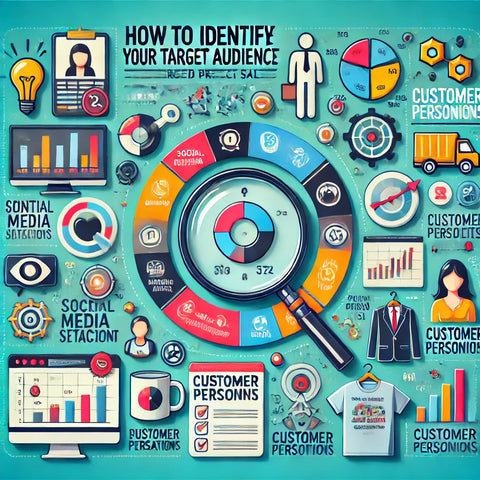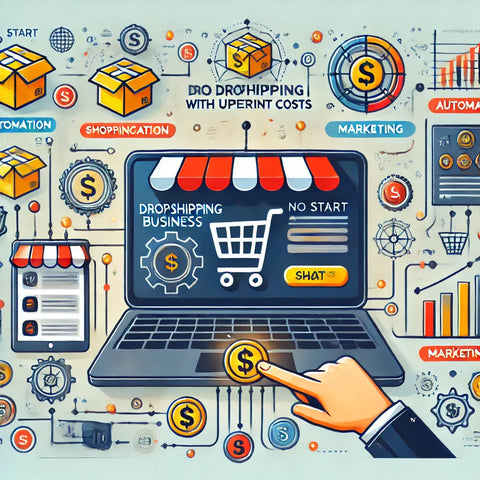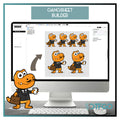One of the biggest mistakes print-on-demand and custom product sellers make is not knowing their target audience. If you try to sell to everyone, you end up selling to no one.
But how do you find the right customers for your t-shirts, hoodies, tote bags, and other printed products?
In this guide, we’ll walk you through how to analyze your target market and use this information to maximize your print-on-demand sales.
1. Why Defining Your Target Audience Matters
✔ Higher Conversion Rates – When you target the right people, they are more likely to buy.
✔ Better Marketing ROI – Avoid wasting money on ads reaching the wrong audience.
✔ Stronger Brand Loyalty – A niche audience will follow and recommend your brand.
✔ Easier Product Development – You’ll know what designs, slogans, and styles will sell best.
📌 Example: A DTF print store selling custom gaming-themed t-shirts should focus on gamers, not general fashion buyers.
🚀 Pro Tip: The more specific your audience, the easier it is to market and sell your products.
2. Step-by-Step Guide to Finding Your Target Audience
Now, let’s break down how to analyze and define your target customers for printed product sales.
1️⃣ Identify Your Niche & Product Type
Before targeting customers, define what you sell and who would buy it.
✔ What Type of Printed Products Are You Selling?
- Custom DTF-printed apparel (t-shirts, hoodies, sweatshirts).
- Personalized gifts (mugs, phone cases, tote bags).
- Business merchandise (branded promotional items).
✔ Who Would Be Interested in These Products?
- Young adults? Parents? Pet lovers? Entrepreneurs? Athletes?
📌 Example: If you sell DTF-printed hoodies with anime designs, your main audience is likely anime fans aged 16-30.
🚀 Pro Tip: The more niche your market, the less competition you have.
2️⃣ Research Your Ideal Customers
Once you know your niche, it’s time to study your potential buyers.
✔ Demographics (Who Are They?)
- Age – Are they teens, adults, parents?
- Gender – Are they male, female, or both?
- Income Level – Can they afford premium products or do they prefer budget-friendly options?
- Location – Are they in the US, Europe, or worldwide?
✔ Psychographics (What Do They Like?)
- Interests & Hobbies – Are they into gaming, sports, eco-living?
- Shopping Behavior – Do they shop on Etsy, Shopify, Amazon?
- Style Preferences – Do they love minimalist, bold, or retro designs?
📌 Example: If you sell fitness-themed DTF-printed shirts, your target audience might be gym enthusiasts, personal trainers, and active lifestyle individuals aged 18-40.
🚀 Pro Tip: Join Facebook groups, Reddit communities, and TikTok trends to understand your audience’s preferences.
3️⃣ Analyze Your Competitors’ Customers
If similar brands are already selling successfully, study who their customers are.
✔ How to Research Competitor Audiences:
- Look at their social media followers (Instagram, TikTok).
- Check reviews & comments to see who buys from them.
- Use Facebook Ads Library to view their active ads.
📌 Example: If a popular Etsy store is selling personalized pet hoodies, analyze their best-selling listings and customer reviews.
🚀 Pro Tip: Take inspiration from competitors, but create a unique angle to stand out.
4️⃣ Test & Validate Your Audience
Before investing heavily in marketing, test your product with a small audience.
✔ Best Ways to Test Your Audience:
- Run small Facebook or Instagram ads to specific age groups & interests.
- Create sample designs and post them on Reddit or TikTok for feedback.
- Offer limited-time discounts to early customers and collect data.
📌 Example: If you’re unsure whether coffee lovers or book lovers would buy your printed tote bags, create two versions and run separate Instagram ads.
🚀 Pro Tip: Use A/B testing to compare which audience converts better.
3. How to Market Your Printed Products to Your Target Audience
Once you know who your customers are, here’s how to reach them effectively.
1️⃣ Social Media Marketing
✔ Instagram & TikTok – Post lifestyle shots, behind-the-scenes videos, and viral trends.
✔ Facebook Groups – Engage in niche-specific communities (e.g., anime groups for anime merch).
✔ Pinterest & Etsy SEO – Optimize product titles & descriptions for organic search.
📌 Example: A print shop selling eco-friendly tote bags can target sustainability influencers on Instagram.
🚀 Pro Tip: Post customer testimonials & user-generated content to build trust.
2️⃣ Influencer Collaborations
✔ Micro-Influencers (5K-50K Followers) – More affordable and highly engaged audiences.
✔ YouTube Reviews – Offer free samples in exchange for product showcases.
✔ TikTok Trends – Partner with creators for viral product challenges.
📌 Example: A custom streetwear brand could work with fashion YouTubers or sneaker influencers.
🚀 Pro Tip: Influencer referral codes encourage more conversions.
3️⃣ Paid Advertising (Facebook & Google Ads)
✔ Target Interests & Demographics – Facebook Ads allow you to target specific groups.
✔ Retarget Abandoned Carts – Use retargeting ads to convert visitors into buyers.
✔ Google Shopping Ads – Display products to people actively searching for them.
📌 Example: A custom hoodie store can target streetwear fans aged 18-35 with Facebook ads.
🚀 Pro Tip: Start with low-budget ads ($5-$10/day) and scale based on performance.
4️⃣ Email & SMS Marketing
✔ Build an Email List – Collect emails with discounts or free guides.
✔ Send Personalized Offers – Offer limited-time promos based on shopping behavior.
✔ Use SMS Reminders – Convert abandoned carts into completed sales.
📌 Example: If someone browses your DTF transfer designs but doesn’t buy, send them a 10% off coupon via email.
🚀 Pro Tip: Repeat customers spend 67% more than first-time buyers—nurture them!
Final Thoughts: Identify & Target the Right Audience for Success
Finding the right customers for your printed products is the foundation of a profitable business.
📌 Key Takeaways:
✔ Define your niche & unique product appeal.
✔ Research your ideal audience’s demographics & interests.
✔ Analyze competitor customers to gain insights.
✔ Test small audiences with social media ads & A/B testing.
✔ Market strategically using SEO, social media, and influencer collaborations.
🚀 Ready to grow your sales? Start targeting the right audience today and watch your business thrive!






